Birds in the News #40 -- Christmas Edition
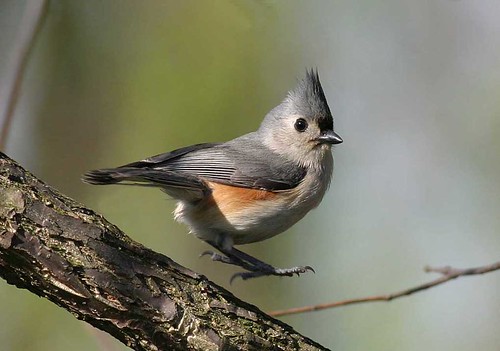
Tufted Titmouse, Baeolophus bicolor, copyright by Doris Dumrauf.
Winner of WildBird Magazine's 2005 amateur photography contest
(Click image for larger picture in its own window).
Photograph appears here with permission of Doris Dumrauf.
Birds in Science
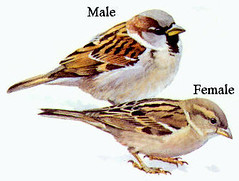 It took years of study and involved weighing 10,000 sparrows, but Scottish scientists believe they have discovered a vital clue that could unravel the mystery surrounding the dramatic decline of one of Britain's best-known birds. Research results showed that house sparrows, Passer domesticus (pictured), fail to prepare effectively for the low food supplies and freezing temperatures during winter months. Instead of eating extra food before cold weather, sparrows retain their sleeker shape to allow them a better chance of fleeing predators -- despite the disadvantage of having a low body weight when the temperatures drop. The study, a collaboration between the British Trust for Ornithology (BTO) and the universities of Glasgow, St Andrews and Oxford, also explained sparrows' susceptibility as resulting from habitat change: Cleaner towns and cities, as well as intensive farming (which reduces the amount of spilled grain and the seed-rich winter stubble favored by sparrows) have reduced the amount of food available to the birds in the winter.
It took years of study and involved weighing 10,000 sparrows, but Scottish scientists believe they have discovered a vital clue that could unravel the mystery surrounding the dramatic decline of one of Britain's best-known birds. Research results showed that house sparrows, Passer domesticus (pictured), fail to prepare effectively for the low food supplies and freezing temperatures during winter months. Instead of eating extra food before cold weather, sparrows retain their sleeker shape to allow them a better chance of fleeing predators -- despite the disadvantage of having a low body weight when the temperatures drop. The study, a collaboration between the British Trust for Ornithology (BTO) and the universities of Glasgow, St Andrews and Oxford, also explained sparrows' susceptibility as resulting from habitat change: Cleaner towns and cities, as well as intensive farming (which reduces the amount of spilled grain and the seed-rich winter stubble favored by sparrows) have reduced the amount of food available to the birds in the winter.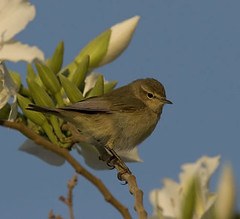 Global warming has apparently lulled Europe's songbirds into canceling their winter stays in Africa. Instead, they'll warble in Britain, bird experts say. Eleven species of migratory warblers wintered in Britain last year and reports from more than a thousand British birdwatchers included sightings of approximately 1,500 blackcaps, Sylvia atricapilla, and almost 1,000 chiffchaffs, Phylloscopus collybita (pictured). "I am amazed by the numbers of warblers that were reported," says Greg Conway, a researcher with the British Trust for Ornithology (BTO), who runs the survey. It's as if the birds are now saying, "Let's not bother to go all the way to Africa this winter." Increasingly mild winters mean the birds can now cope with Europe's coldest months, giving them a head start when choosing territories the following breeding season. "Because they have the best breeding sites, they have the best productivity. And because it's a genetic trait, they are pumping out more and more kids which come (to Britain in the winter)." As for food, the BTO says bird feeders and berry-laden shrubs in gardens are helping blackcaps get through the lean winter months. GrrlScientist notes; but see the report below (People Helping Birds) that discusses how many British birds are dying of starvation due to massive failure of seed crops, forcing them to fight over rapidly diminishing berry crops.
Global warming has apparently lulled Europe's songbirds into canceling their winter stays in Africa. Instead, they'll warble in Britain, bird experts say. Eleven species of migratory warblers wintered in Britain last year and reports from more than a thousand British birdwatchers included sightings of approximately 1,500 blackcaps, Sylvia atricapilla, and almost 1,000 chiffchaffs, Phylloscopus collybita (pictured). "I am amazed by the numbers of warblers that were reported," says Greg Conway, a researcher with the British Trust for Ornithology (BTO), who runs the survey. It's as if the birds are now saying, "Let's not bother to go all the way to Africa this winter." Increasingly mild winters mean the birds can now cope with Europe's coldest months, giving them a head start when choosing territories the following breeding season. "Because they have the best breeding sites, they have the best productivity. And because it's a genetic trait, they are pumping out more and more kids which come (to Britain in the winter)." As for food, the BTO says bird feeders and berry-laden shrubs in gardens are helping blackcaps get through the lean winter months. GrrlScientist notes; but see the report below (People Helping Birds) that discusses how many British birds are dying of starvation due to massive failure of seed crops, forcing them to fight over rapidly diminishing berry crops.Christmas Bird Count News
 Will "winter finches" or northern raptors spread across North America this December? Will snow and ice blanket this continent, or will mild conditions prevail until the New Year? Will observers along the storm-ravaged Gulf Coast be able to discover the effects of this summer's hurricanes on their local birds? More than 50,000 observers in hundreds of locations throughout the United States and Canada, the Caribbean, parts of South and Central America, Bermuda, the West Indies and even a few Pacific Islands will be outside counting birds to find out. The Christmas Bird Count, also known as the CBC, now under the supervision of the National Audubon Society, began 106 years ago when a couple dozen birdwatchers replaced the traditional Christmas Day bird hunt with a day of bird observation. The annual Christmas Bird Count starts on 14 December and extends through 5 January in any given year. Each official CBC location consists of a 15 mile-diameter circle. Observers start out before dawn, listening for owl calls, then drive and walk through woods, fields, wetlands and along lakes and streams from dawn to dusk, noting not only how many different species they can find, but the numbers of each species. Participants are not paid for the count. In fact, they each contribute a $5 fee to cover the cost of printing official lists, preparing other materials and publishing the results. For more information, click each link to view; this year's CBC results, and here to see last year's (105th CBC) photo gallery. You can join the National Audubon Society (always a great gift idea for that person on your list who has everything).
Will "winter finches" or northern raptors spread across North America this December? Will snow and ice blanket this continent, or will mild conditions prevail until the New Year? Will observers along the storm-ravaged Gulf Coast be able to discover the effects of this summer's hurricanes on their local birds? More than 50,000 observers in hundreds of locations throughout the United States and Canada, the Caribbean, parts of South and Central America, Bermuda, the West Indies and even a few Pacific Islands will be outside counting birds to find out. The Christmas Bird Count, also known as the CBC, now under the supervision of the National Audubon Society, began 106 years ago when a couple dozen birdwatchers replaced the traditional Christmas Day bird hunt with a day of bird observation. The annual Christmas Bird Count starts on 14 December and extends through 5 January in any given year. Each official CBC location consists of a 15 mile-diameter circle. Observers start out before dawn, listening for owl calls, then drive and walk through woods, fields, wetlands and along lakes and streams from dawn to dusk, noting not only how many different species they can find, but the numbers of each species. Participants are not paid for the count. In fact, they each contribute a $5 fee to cover the cost of printing official lists, preparing other materials and publishing the results. For more information, click each link to view; this year's CBC results, and here to see last year's (105th CBC) photo gallery. You can join the National Audubon Society (always a great gift idea for that person on your list who has everything). 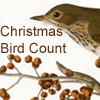
- Regional CBC news stories;
Hamilton County, Indiana (USA): 41 birdwatchers counted 63 species of birds on 17 December.
Southern Illinois (USA) 8 birdwatchers compiled an impressive list of 95 species on December 17. (You have to read their list to believe it!)
Maine (USA): 32 volunteers counted 53 species of birds.
Huntsville, Ontario (Canada): 20 participants counted 38 species of birds on 17 December.
GrrlScientist note: Please email links to your CBC news stories and I will publish them in next week's issue.
People Helping Birds
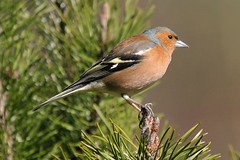 British Trust for Ornithology (BTO) is encouraging people to put out supplemental food for wild birds who are suffering from food shortages after the failure of several seed crops, with fears many could die of starvation before the end of the winter. Three major sources of food -- oak, beech and fir trees -- have failed to produce much fruit this year, leaving birds such as woodpigeons, Columba palumbus, coal tits, Periparus ater, and chaffinches, Fringilla coelebs (pictured), struggling. It is highly unusual for all three seed crops to fail in the same year, according to the BTO. As a result, these birds have now started feeding on berries much earlier than normal, putting them in competition with species such as the robin, Erithacus rubecula, and long-tailed tit, Aegithalos caudatus. Mike Toms, of the BTO, said: "What this means for our garden birds is that a food source which would normally last them through the winter months is already pretty much exhausted." A severe cold spell at the beginning of December has made conditions even worse, leading to trees being stripped earlier than they would have been. "The food that garden owners put out for birds could be the difference between life and death for many species," Toms said.
British Trust for Ornithology (BTO) is encouraging people to put out supplemental food for wild birds who are suffering from food shortages after the failure of several seed crops, with fears many could die of starvation before the end of the winter. Three major sources of food -- oak, beech and fir trees -- have failed to produce much fruit this year, leaving birds such as woodpigeons, Columba palumbus, coal tits, Periparus ater, and chaffinches, Fringilla coelebs (pictured), struggling. It is highly unusual for all three seed crops to fail in the same year, according to the BTO. As a result, these birds have now started feeding on berries much earlier than normal, putting them in competition with species such as the robin, Erithacus rubecula, and long-tailed tit, Aegithalos caudatus. Mike Toms, of the BTO, said: "What this means for our garden birds is that a food source which would normally last them through the winter months is already pretty much exhausted." A severe cold spell at the beginning of December has made conditions even worse, leading to trees being stripped earlier than they would have been. "The food that garden owners put out for birds could be the difference between life and death for many species," Toms said.People Hurting Birds
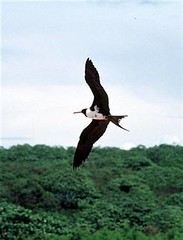 How far would you travel to feed your baby? A female Christmas Island Frigatebird, Fregata andrewsi (pictured), named Lydia, recently made a 26-day journey of about 2,500 miles across Indonesian volcanoes and some of Asia's busiest shipping lanes, in search of food for her chick. The trip, tracked with a global positioning device by scientists at Christmas Island National Park, is by far the longest known nonstop journey by one of these critically endangered seabirds. Previously, the black-and-white scavengers with distinctive pink beaks and wingspans of up to 8 feet were known only to fly a few hundred miles from their nesting sites, staying away for just a few days at a time, officials said. "The thing that really surprised me is that it was a long, nonstop journey, and that she crossed overland over volcanoes," said David James, coordinator of biodiversity monitoring for Christmas Island National Park, the birds' only known breeding ground. "Normally, you would expect the seabirds to fly over the sea." Lydia's trip started October 18 from Christmas Island, an Australian territory in the Indian Ocean approximately 310 miles south of Indonesia's capital, Jakarta, and 1,600 miles northwest of Perth, in western Australia. "It is tragically ironic that while Lydia nests on one the world's most remote and pristine islands, she makes her living in some of the most degraded seas on the planet," James said. "Fishing pressure is huge and marine pollution is severe." GrrlScientist wonders; In view of Alexander Kitaysky's research on the diet of young kittiwakes, I wonder how good this chick's chances are of surviving into adulthood and reproducing?
How far would you travel to feed your baby? A female Christmas Island Frigatebird, Fregata andrewsi (pictured), named Lydia, recently made a 26-day journey of about 2,500 miles across Indonesian volcanoes and some of Asia's busiest shipping lanes, in search of food for her chick. The trip, tracked with a global positioning device by scientists at Christmas Island National Park, is by far the longest known nonstop journey by one of these critically endangered seabirds. Previously, the black-and-white scavengers with distinctive pink beaks and wingspans of up to 8 feet were known only to fly a few hundred miles from their nesting sites, staying away for just a few days at a time, officials said. "The thing that really surprised me is that it was a long, nonstop journey, and that she crossed overland over volcanoes," said David James, coordinator of biodiversity monitoring for Christmas Island National Park, the birds' only known breeding ground. "Normally, you would expect the seabirds to fly over the sea." Lydia's trip started October 18 from Christmas Island, an Australian territory in the Indian Ocean approximately 310 miles south of Indonesia's capital, Jakarta, and 1,600 miles northwest of Perth, in western Australia. "It is tragically ironic that while Lydia nests on one the world's most remote and pristine islands, she makes her living in some of the most degraded seas on the planet," James said. "Fishing pressure is huge and marine pollution is severe." GrrlScientist wonders; In view of Alexander Kitaysky's research on the diet of young kittiwakes, I wonder how good this chick's chances are of surviving into adulthood and reproducing?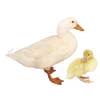 Two domestic ducks have been rescued after two residents found them swimming among wild ducks in a corner of the library's mostly frozen duck pond. "I'd hate to come out here someday and see them frozen," said Diane Holmgren, at the duck pond before the rescue last week, where she walks nearly every day with her husband, Frank. Holmgren called animal control, the Humane Society and Recreation and Parks, afraid that the ducks wouldn't survive the winter. Unfortunately, these birds are not as unusual as one might think. In fact, they are part of a growing national problem known as unwanted pet syndrome. "I get about a half-dozen e-mails a day from all over the country asking for help because white Pekin ducks (pictured) are getting frostbite and frozen and being euthanized. It's horrifying," said Kim Link, co-president of Majestic Waterfowl Sanctuary in Lebanon, Connecticut, one of only a handful of shelters set up to accommodate domestic waterfowl that have been rescued. "Folks see ducks on ponds and decide to set their ducks 'free' to live happily ever after. What they don't realize is that domestic ducks do not fly. They are not free and they are not wild. They are trapped on the ponds they are abandoned to. They can't migrate. They lose their food supply. The pond freezes over, they get frostbit legs and bills, they freeze into the ice -- if only people knew what they were doing." Rescued waterfowl are in need of loving and safe, predator-proof homes. Click here if you would like to help.
Two domestic ducks have been rescued after two residents found them swimming among wild ducks in a corner of the library's mostly frozen duck pond. "I'd hate to come out here someday and see them frozen," said Diane Holmgren, at the duck pond before the rescue last week, where she walks nearly every day with her husband, Frank. Holmgren called animal control, the Humane Society and Recreation and Parks, afraid that the ducks wouldn't survive the winter. Unfortunately, these birds are not as unusual as one might think. In fact, they are part of a growing national problem known as unwanted pet syndrome. "I get about a half-dozen e-mails a day from all over the country asking for help because white Pekin ducks (pictured) are getting frostbite and frozen and being euthanized. It's horrifying," said Kim Link, co-president of Majestic Waterfowl Sanctuary in Lebanon, Connecticut, one of only a handful of shelters set up to accommodate domestic waterfowl that have been rescued. "Folks see ducks on ponds and decide to set their ducks 'free' to live happily ever after. What they don't realize is that domestic ducks do not fly. They are not free and they are not wild. They are trapped on the ponds they are abandoned to. They can't migrate. They lose their food supply. The pond freezes over, they get frostbit legs and bills, they freeze into the ice -- if only people knew what they were doing." Rescued waterfowl are in need of loving and safe, predator-proof homes. Click here if you would like to help. Streaming Birds
 On BirdNote, for the week of December 19, learn more about rete mirabile, the reason that birds' feet don't freeze. Also; swallows in winter?; solstice fires and the return of the sun; why woodpeckers don't get headaches; and today's show, The Twelve Days of Christmas -- the derivation. BirdNote programs are two-minute vignettes that incorporate the rich sounds of birds provided by Cornell University and by other sound recordists, with photographs and written stories that illustrate the interesting -- and in some cases, truly amazing -- abilities of birds. Some of the shows are Pacific Northwest-oriented, but many are of general interest. BirdNote can be heard live, Monday through Friday, 8:58-9:00AM in Western Washington state and Southern British Columbia on KPLU radio and now also in North Central Washington state on KOHO radio. All episodes are available in the BirdNote archives, both in written transcript and mp3 formats, along with photographs. Listener ideas and comments are welcomed. [mp3/podcast].
On BirdNote, for the week of December 19, learn more about rete mirabile, the reason that birds' feet don't freeze. Also; swallows in winter?; solstice fires and the return of the sun; why woodpeckers don't get headaches; and today's show, The Twelve Days of Christmas -- the derivation. BirdNote programs are two-minute vignettes that incorporate the rich sounds of birds provided by Cornell University and by other sound recordists, with photographs and written stories that illustrate the interesting -- and in some cases, truly amazing -- abilities of birds. Some of the shows are Pacific Northwest-oriented, but many are of general interest. BirdNote can be heard live, Monday through Friday, 8:58-9:00AM in Western Washington state and Southern British Columbia on KPLU radio and now also in North Central Washington state on KOHO radio. All episodes are available in the BirdNote archives, both in written transcript and mp3 formats, along with photographs. Listener ideas and comments are welcomed. [mp3/podcast]. 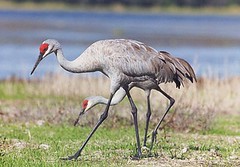 An obscure area in New Mexico called Bosque Del Apache is where the world's largest concentration of sandhill cranes, Grus canadensis (pictured), migrate every fall. Every year, Bosque Del Apache hosts upwards of 20,000 cranes and these majestic and ancient birds form seas of blue along the Rio Grande. Writer Doug Fine watched some of this year's migration and reports about it for Morning Edition, heard on National Public Radio. [3:19, RealPlayer or Windoze Media Player required]
An obscure area in New Mexico called Bosque Del Apache is where the world's largest concentration of sandhill cranes, Grus canadensis (pictured), migrate every fall. Every year, Bosque Del Apache hosts upwards of 20,000 cranes and these majestic and ancient birds form seas of blue along the Rio Grande. Writer Doug Fine watched some of this year's migration and reports about it for Morning Edition, heard on National Public Radio. [3:19, RealPlayer or Windoze Media Player required]Miscellaneous Birds

Mark Brazil is the author of my constant companion, The Birds of Japan (pictured), when I visited Tokyo for six weeks a few years ago. In this article, he expounds upon the joys of birding in the nude in Japan. Need I say more?
Mistletoe, a plant that is distributed by birds, has been associated with Christmas for centuries. In fact, this plant's name is derived from old English, meaning "dung on a twig", because it frequently is propagated from bird poop found on twigs of trees. Now, just in time for Christmas, you can read a nicely written and photographed natural history about mistletoe that is featured at This Week at Hilton Pond (scroll down a little on that link). As always, the naturalists at Hilton Pond include a tally of birds banded there, as well as miscellaneous notes about local nature happenings. Hilton Pond Center for Piedmont Natural History is a non-profit research & education organization located in York, South Carolina, USA.
The fine print: Thanks to my bird pals, Bill, Caren, Ellen and Ron, for some of the news story links that you are enjoying here and thanks to Ian and Candy for correcting my errors. Best regards to Lawrence B. and to anonymous for their generous $upport. And special thanks to long-time readers, Jamie, Tony and anonymous blog reader, for surprising me by nominating Birds in the News for a 2005 Koufax Award for Best Series! There will be an announcement here, along with more details, when voting begins. As an aside, it has come to my attention that Internet Explorer does not respect the formatting of this blog. I apologize because I am not sure how to rectify this situation except to say that this blog looks best when viewed with Firefox.
tags: Birds in the News, ornithology, birds, avian, newsletter, Christmas Bird Count

© 2004, 2005, 2006 by GrrlScientist











13 Peer Reviews:
Have you listened to the Talk Of The Nation - Science Friday on NPR today? It was about birding , Christmas count, and the Ivory Bill Woodpecker. They played several audi-files of the ivory-bill. I am sure they will post the podcast soon.
I have so much reading to catch up on your blog. Help!! I also got a few bird pictures (tourist type) in Hawaii that I will post when I journal my trip.
Coturnix; bummer, i missed that broadcast because i was on the subway (but this is better than walking 8 million miles, even if i can listen to my radio while i walk!). i will be eagerly looking for the link on the NPR site.
Tabor; i can hardly wait to see your pictures!
GrrlScientist
This comment has been removed by a blog administrator.
You've been tagged for a meme....
Oops!
Great xmas present to your readers! Don't forget to mention (and participate in) Cornell's Project Feeder Watch and the upcoming Great Backyard Bird Count. And put out some suet and keep the ice off the bird baths for the little buggers!
NPR mentioned the theft of a baby Jackass Penguin from a British zoo park yesterday, and mentioned this is a common (though not this time, apparently) urban legend. How odd.
trackback (or, instead of one...)
Greetings -- I'm another female ornith systematist confused by the career sphere. I might identify myself later, but wanted to say -- your blog is great, and I was anxious to hear what News you expected to have on or around Dec 15, or don't you want to say? Also "cooking with your lorie" was hysterical and much appreciated; as a kid I had an African Grey who liked to eat my books.
Coturnix; thanks for thinking of me.
Jamie; yes, i missed the penguin theft story! amazing that would happen, with my multi-layered network and all. the worst thing was that some friends were talking about it the day it happened and i never asked them for the URL to the story.
Anonymous; the news isn't that great (a job). instead, my news is that this blog is moving to a new location. i will provide more details as soon as i have them myself.
i am sure that you know i have an african grey, the gift bird, zazu. i will try to post a few comments about him soon. i know that another reader has asked me to write more about him.
GrrlScientist
Ok, tell me, is this common sparrow the same bird that is a pest here in the U.S.?
yes, indeed it is.
The house sparrow "that is a pest here in the U.S." isn't much of a pest here in Central NE. Our yard hosts a total of 8 birds; previous years highs were in the low 100s. famedsnake6.
famedsnake6; house sparrows (i prefer to call them "english sparrows") are more dependent upon large conglomerations of people than what are available in the midwest (well, except for chicago). it's definitely a "city bird".
what happened to all your yard birds this year? any ideas?
Thanks, Wise Crow, for the CBC results. can you tell me what state freeport is located in so i can report these results?
GrrlScientist
Post a Comment
<< Home